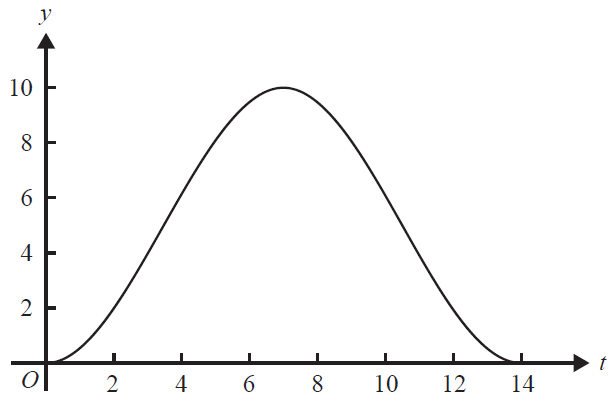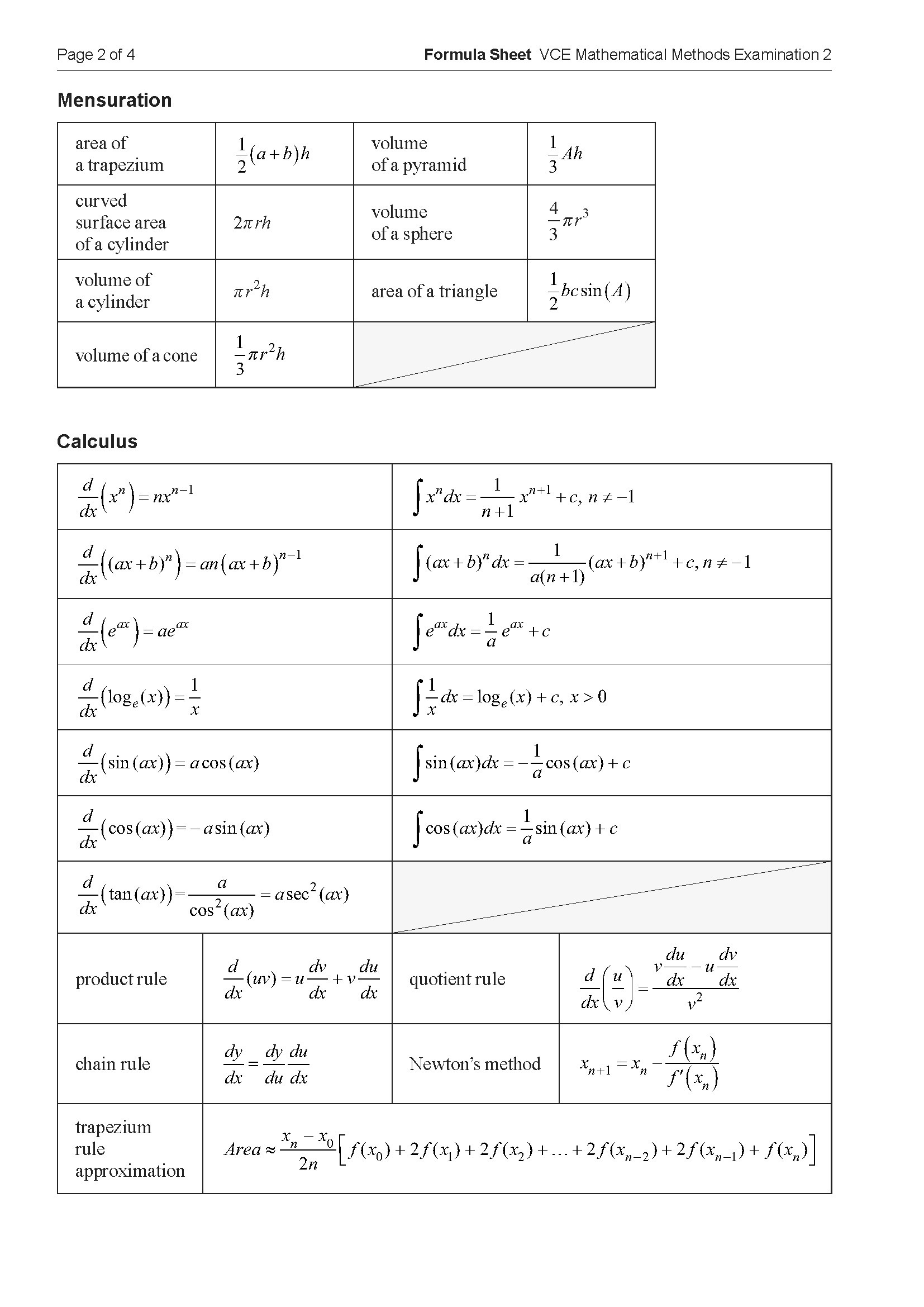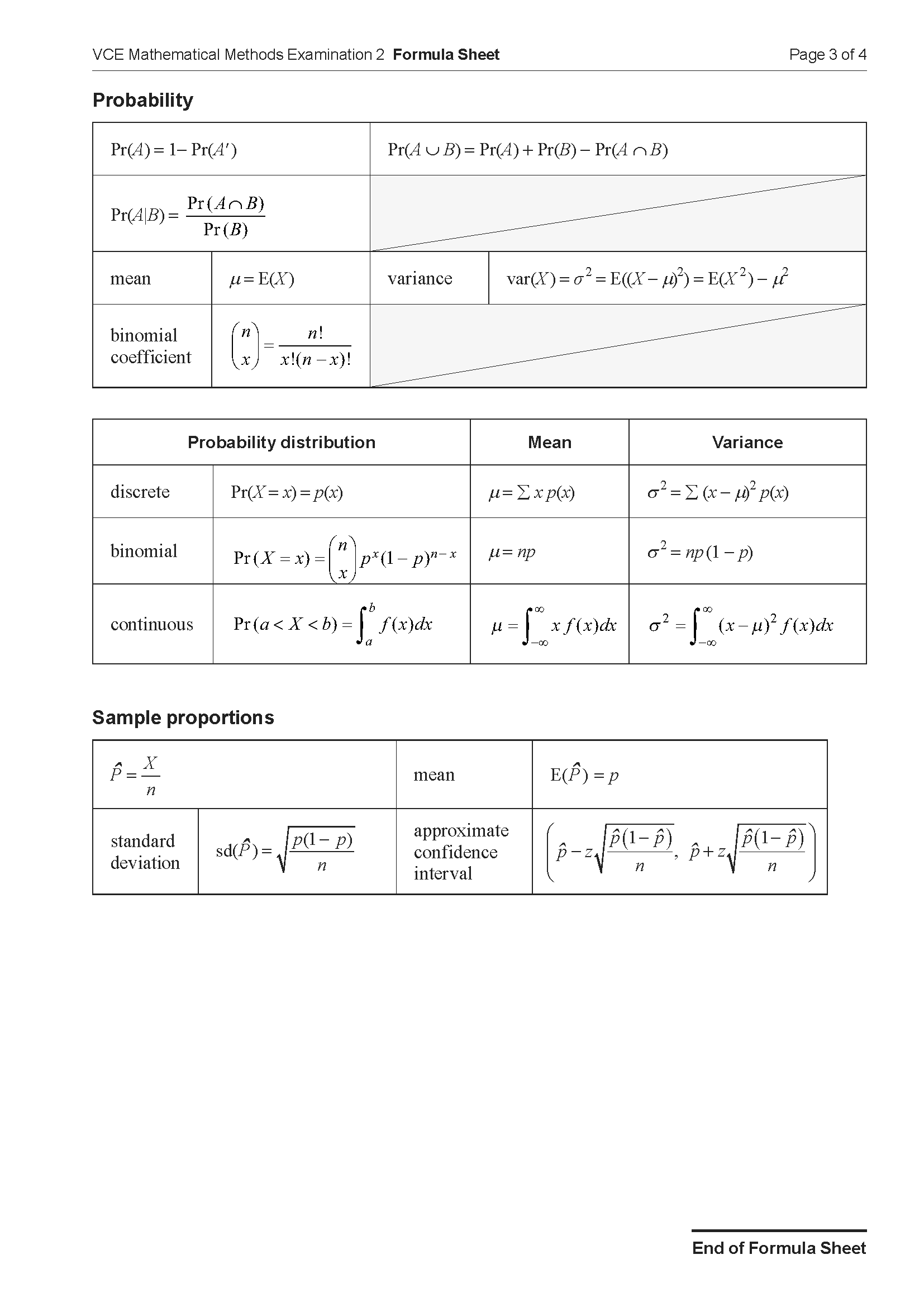2016 VCE Maths Methods Mini Test 7
Number of marks: 10
Reading time: 2 minutes
Writing time: 15 minutes
Section A – Calculator Allowed
Instructions
• Answer all questions in pencil on your Multiple-Choice Answer Sheet.
• Choose the response that is correct for the question.
• A correct answer scores 1; an incorrect answer scores 0.
• Marks will not be deducted for incorrect answers.
• No marks will be given if more than one answer is completed for any question.
• Unless otherwise indicated, the diagrams in this book are not drawn to scale.
Consider the graph of the function defined by \(f: [0, 2\pi] \to R, f(x) = \sin(2x)\).
The square of the length of the line segment joining the points on the graph for which \(x = \frac{\pi}{4}\) and \(x = \frac{3\pi}{4}\) is
- A. \(\frac{\pi^2+16}{4}\)
- B. \(\pi+4\)
- C. 4
- D. \(\frac{3\pi^2+16\pi}{4}\)
- E. \(\frac{10\pi^2}{16}\)
The number of pets, \(X\), owned by each student in a large school is a random variable with the following discrete probability distribution.
| \(x\) | 0 | 1 | 2 | 3 |
| \(\Pr(X=x)\) | 0.5 | 0.25 | 0.2 | 0.05 |
If two students are selected at random, the probability that they own the same number of pets is
- A. 0.3
- B. 0.305
- C. 0.355
- D. 0.405
- E. 0.8
The UV index, \(y\), for a summer day in Melbourne is illustrated in the graph below, where \(t\) is the number of hours after 6 am.

The graph is most likely to be the graph of
- A. \(y = 5 + 5\cos\left(\frac{\pi t}{7}\right)\)
- B. \(y = 5 - 5\cos\left(\frac{\pi t}{7}\right)\)
- C. \(y = 5 + 5\cos\left(\frac{\pi t}{14}\right)\)
- D. \(y = 5 - 5\cos\left(\frac{\pi t}{14}\right)\)
- E. \(y = 5 + 5\sin\left(\frac{\pi t}{14}\right)\)
Given that \(\frac{d(xe^{kx})}{dx}) = (kx+1)e^{kx}\), then \(\int xe^{kx} dx\) is equal to
- A. \(\frac{xe^{kx}}{kx+1} + c\)
- B. \((\frac{kx+1}{k})e^{kx} + c\)
- C. \(\frac{1}{k}\int e^{kx} dx\)
- D. \(\frac{1}{k}(xe^{kx} - \int e^{kx} dx) + c\)
- E. \(\frac{1}{k^2}(xe^{kx} - e^{kx}) + c\)
For the curve \(y = x^2 - 5\), the tangent to the curve will be parallel to the line connecting the positive \(x\)-intercept and the \(y\)-intercept when \(x\) is equal to
- A. \(\sqrt{5}\)
- B. 5
- C. -5
- D. \(\frac{\sqrt{5}}{2}\)
- E. \(\frac{1}{\sqrt{5}}\)
End of Section A
Section B – No Calculator
Instructions
• Answer all questions in the spaces provided.
• Write your responses in English.
• In questions where a numerical answer is required, an exact value must be given unless otherwise specified.
• In questions where more than one mark is available, appropriate working must be shown.
• Unless otherwise indicated, the diagrams in this book are not drawn to scale.
Let \(f: [-\pi, \pi] \to R\), where \(f(x) = 2\sin(2x) - 1\).
a. Calculate the average rate of change of \(f\) between \(x = -\frac{\pi}{3}\) and \(x = \frac{\pi}{6}\). 2 marks
b. Calculate the average value of \(f\) over the interval \(-\frac{\pi}{3} \le x \le \frac{\pi}{6}\). 3 marks
End of examination questions
VCE is a registered trademark of the VCAA. The VCAA does not endorse or make any warranties regarding this study resource. Past VCE exams and related content can be accessed directly at www.vcaa.vic.edu.au

